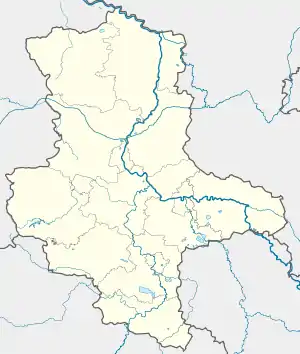Monastery of Goseck
Goseck, a monastery built on the foundations of a castle, as well as the vineyard of Dechantenberg is located in the municipality of Goseck of Saxony-Anhalt in Germany. It has been proposed by Germany for inscription in the List of World Heritage. The World Heritage nomination Naumburg Cathedral and the High Medieval Cultural Landscape of the Rivers Saale and Unstrut is a representative of the processes that shaped the continent during the High Middle Ages between 1000 and 1300: Christianization, the so-called "Landesausbau" and the dynamics of cultural exchange and transfer characteristic for this very period.[1]
| Goseck | |
|---|---|
 Goseck Location within Saxony-Anhalt  Goseck Goseck (Germany) | |
| General information | |
| Type | Monastery |
| Location | Saxony-Anhalt |
| Country | Germany |
| Coordinates | 51°11′25″N 11°52′11″E |
| Landlord | Foundation "Dome und Schlösser Sachsen-Anhalt" |
World Heritage Nomination
Goseck and its vineyard is one of the eleven components of the cultural landscape Naumburg Cathedral and the High Medieval Cultural Landscape of the Rivers Saale and Unstrut. Together with the agricultural features on the northern slopes of the Saale and the sandstone quarries used for the building of the monastery, this ensemble conveys the different forms of land use of the medieval monastery structures.[2]
History

Goseck Castle was part of a network of Frankish castles on the Saale River. It was founded around the year 800. The counts of Goseck were one of the noblest aristocratic families of the empire in the 10th and 11th century.[3] Count Frederick I of Goseck had his center of power in Goseck . In 1041, Adalbert (archbishop of Hamburg-Bremen from 1043) founded a Benedictine monastery in the eastern part of the noble castle of Goseck. The minster was erected in 1046.[4]
Location
It is situated 9 kilometers northeast of Naumburg across the Saale Valley on the opposite bank. This monastery of the 11th century is a preserved and documented structure of the High Middle Ages. It was built to be visible from afar, offering lines of sight to most of the monuments in the nominated areas.
Architecture
The crypt and choir of the monastery church display the very best of Salian architecture. Goseck is an example for the transformation of a noble family's hereditary seat into a monastery with dynastic memorial tasks.[5]
Viniculture
In the chronicles of the Benedictines of the Goseck monastery the terraced vineyard below the site is dated back to the year 1093; it is the oldest vineyard in continuous use in the nominated region. The Dechantenberg vineyard is exposed to the south.
Today
Around 1540, the monastery was secularized. Since 1997, Goseck is owned by the »Landesstiftung Dome und Schlösser Sachsen-Anhalt«, a state foundation endowed by the State of Saxony-Anhalt . Today, a European Centre for Music and Culture ("Europäisches Musik und Kulturzentrum") resides in Goseck and offers a range of cultural activities.[note 1]
See also
References
- Bartlett, Robert (1994). The Making of Europe: Conquest, Colonization and Cultural Change 950-1350. Penguin.
- UNESCO (2017): WHC/17/41.COM/INF.8B1.Nominations to the World Heritage List (Krakow, 2017). UNESCO press. p. 54. Retrieved 5 May 2017.
- Starke, Heinz-Dieter (1955). Die Pfalzgrafen von Sachsen bis zum Jahre 1088. In: Braunschweigisches Jahrbuch 36 [The palsgraves of Saxony until the year 1088.In: Yearbook of Braunschweig 36.] (in German). City of Braunschweig. pp. 24–52.
- Schmitt, Reinhard (1999). Burg, Kloster und Schloss Goseck. Zum Stand der baugeschichtlichen Erforschung. In: Denkmalpflege in Sachsen-Anhalt 7 [Castle, monastery and palace Goseck. Research on the building history. In: Preservation of historical monuments in Saxony-Anhalt 7.] (in German). Saxony-Anhalt. pp. 1–30.
- Schmitt, Reinhard (1999). Quellen zur Geschichte und Baugeschichte von Burg, Kloster und Schloss Goseck. In: Saale-Unstrut-Jahrbuch 4 [Sources on history and building history of the castle, monastery and palace Goseck. In: Yearbook of Saale-Unstrut 4.] (in German). Saxony-Anhalt. pp. 28–43.
Notes
- For further information: http://www.dome-schloesser.de/.